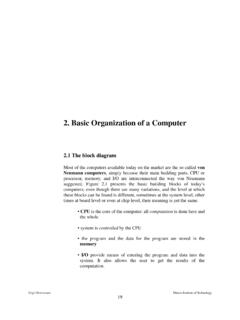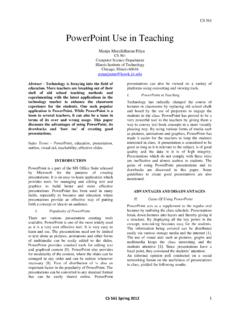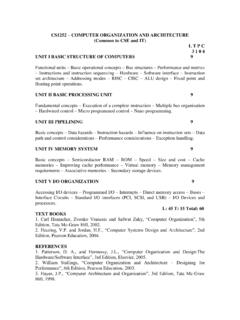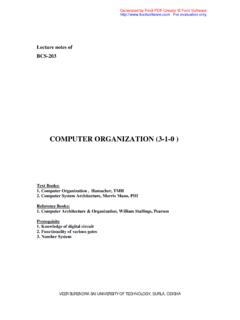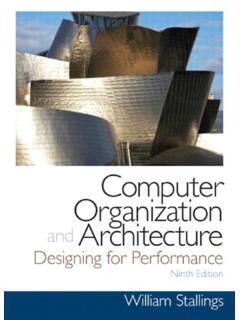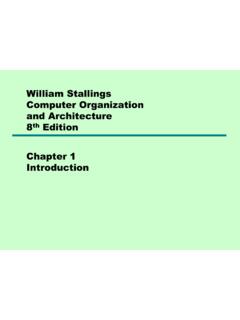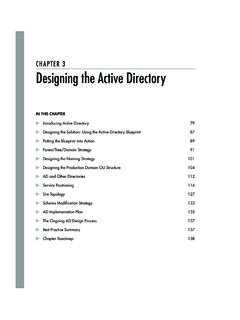Transcription of 1. Fundamentals of Computer Design
1 Virgil Bistriceanu Illinois Institute of Technology31. Fundamentals of Computer IntroductionThe concept of stored program computers appeared in 1945 when John vonNeumann drafted the first version of EDVAC (Electronic Discrete VariableComputer). Those ideas have since been the milestones of computers: an input device through which data and instructions can beentered storage in which data can be read/written; instructions are likedata, they reside in the same memory an arithmetic unit to process data a control unit which fetches instructions, decode and execute them output devices for the user to access the improvements in Computer technology have been tremendous sincethe first machines appeared.
2 A personal Computer that can be bought todaywith a few thousand dollars, has more performance (in terms of, say,floating point multiplications per second), more main memory and moredisk capacity than a machine that cost millions in the Fundamentals of Computer DesignVirgil Bistriceanu Illinois Institute of Technology4 Four lines of evolution have emerged from the first computers (definitionsare very loose and in many case the borders between different classes areblurring):1. Mainframes: large computers that can support very many userswhile delivering great computing power.
3 It is mainly inmainframes where most of the innovations (both in architectureand in organization ) have been Minicomputers: have adopted many of the mainframetechniques, yet being designed to sell for less, satisfying thecomputing needs for smaller groups of users. It is theminicomputer group that improved at the fastest pace (since 1965when DEC introduced the first minicomputer, PDP-8), mainly dueto the evolution of integrated circuits technology (the first ICappeared in 1958).3. Supercomputers: designed for scientific applications, they arethe most expensive computers (over one million dollars),processing is usually done in batch mode, for reasons Microcomputers: have appeared in the microprocessor era(the first microprocessor, Intel 4004, was introduced in 1971).
4 The term micro refers only to physical dimensions, not tocomputing performance. A typical microcomputer (either a PC ora workstation) nicely fits on a desk. Microcomputers are a directproduct of technological advances: faster CPUs, semiconductormemories, etc. Over the time many of the concepts previouslyused in mainframes and minicomputers have become commonplace in many years the evolution of computers was concerned with theproblem of object code compatibility. A new architecture had to be, at leastpartly, compatible with older ones. Older programs ( the dusty deck ) hadto run without changes on the new machines.
5 A dramatic example is theIBM-PC architecture, launched in 1981, it proved so successful that furtherdevelopments had to conform with the first release, despite the flaws whichbecame apparent in a couple of years assembly language is no longer the language in which newapplications are written, although the most sensitive parts continue to bewritten in assembly language, and this is due to advances in languages andcompiler technology. Performance DefinitionVirgil Bistriceanu Illinois Institute of Technology5 The obsolescence of assembly language programming, as well as thecreation of portable operating systems (like UNIX), have reduced the risksof introducing new architectures.
6 New families of computers are emerging,many of them hybrids of classical families: graphical supercomputers,multiprocessors, MPP (Massively Parallel Processors), mini-supercomputers, Performance DefinitionWhat is the meaning of saying that a Computer is faster than another one? Itdepends upon the position you have: if you are a simple user (end user)then you say a Computer is faster when it runs your program in less time,and you think at the time it takes from the moment you launch yourprogram until you get the results, this the so called wall-clock time. On theother hand, if you are system's manager, then you say a Computer is fasterwhen it completes more jobs per time a user you are interested in reducing the response time (also called theexecution time or latency).
7 The Computer manager is more interested inincreasing the throughput (also called bandwidth), the number of jobsdone in a certain amount of time, execution time and throughput are usually connected totasks and whole computational events. Latency and bandwidth are mostlyused when discussing about memory OF SYSTEM ENHANCEMENTS ON RESPONSE TIME, THROUGHPUT:The following system enhancements are considered:a) faster CPUb) separate processors for different tasks (as in an airline reservationsystem or in a credit card processing system)Do these enhancements improve response-time, throughput or both?Answer:A faster CPU decreases the response time and, in the mean time, increasesthe throughputa) both the response-time and throughput are ) several tasks can be processed at the same time, but no one gets donefaster; hence only the throughput is many cases it is not possible to describe the performance, eitherresponse-time or throughput, in terms of constant values but in terms ofsome statistical distribution.
8 This is especially true for I/O operations. One1 Fundamentals of Computer DesignVirgil Bistriceanu Illinois Institute of Technology6can compute the best-case access time for a hard disk as well as the worst-case access time: what happens in real life is that you have a disk requestand the completion time (response-time) which depends not only upon thehardware characteristics of the disk (best/worst case access time), but alsoupon some other facts, like what is the disk doing at the moment you areissuing the request for service, and how long the queue of waiting tasks PerformanceSuppose we have to compare two machines A and B.
9 The phrase A is n%faster thanB means:Because performance is reciprocal to execution time, the above formulacan be written as:Example OF EXECUTION TIMES:If machine A runs a program in 5 seconds, and machine B runs the sameprogram in 6 seconds, how can the execution times be compared?Answer:Machine A is faster than machine B by n% can be written as:%Therefore machine A is by faster than machine B. We can also saythat the performance of the machine A is by better than theperformance of the machine time of BExecution time of A--------------------------------------- ---------1n100---------+=Performance APerformance B------------------------------------1n1 00---------+=Execution_time_BExecution_t ime_A----------------------------------- ----------1n100---------+=nExecution_tim e_B Execution_time_A Execution_time_A------------------------ ---------------------------------------- --------------------------------*100=n65 6------------100
10 Performance DefinitionVirgil Bistriceanu Illinois Institute of Technology7 CPU PerformanceWhat is the time the CPU of your machine is spending in running aprogram? Assuming that your CPU is driven by a constant rate clockgenerator (and this is sure the case), we have:CPUtime = Clock_cycles_for_the_program * Tckwhere Tck is the clock cycle above formula computes the time CPU spends running a program, notthe elapsed time: it does not make sense to compute the elapsed time as afunction of Tck, mainly because the elapsed time also includes the I/O time,and the response time of I/O devices is not a function of we know the number of instructions that are executed since the programstarts until the very end, lets call this the Instruction Count (IC), then wecan compute the average number of clock cycles per instruction (CPI) asfollows:The CPUtime can then be expressed as:The scope of a designer is to lower the CPUtime, and here are theparameters that can be modified to achieve this: IC.
